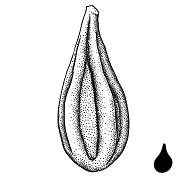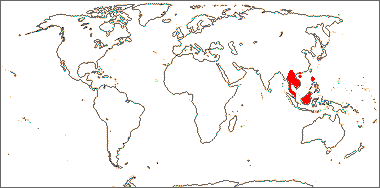Family name: Lowiaceae H. Ridley
Synonym(s): Orchidanthaceae Dostál, nom. inval.
Common name(s): orchidantha family
*Number of genera/species: 1/18
List of genera records in GRIN-Global
seed
Fruit a loculicidalloculicidal:
type of capsular dehiscence, opening longitudinally through the locules (compare septicidal)
 capsulecapsule:
capsulecapsule:
a dry, dehiscent fruit derived from a compound ovary , 10–300 mm long, globoseglobose:
, 10–300 mm long, globoseglobose:
3D shape—more or less spherical to triangulartriangular:
to triangulartriangular:
2D shape—three relatively straight sides with distinct corners; more angular than teardrop-shaped , angledangular:
, angledangular:
2D shape—having sides that meet at acute or obtuse angles
in transection, beakedbeak:
a usually firm, terminal appendage, sometimes tapered (shriveled ovary), with many seeds aligned in two rows. Pericarppericarp:
(shriveled ovary), with many seeds aligned in two rows. Pericarppericarp:
fruit wall or fruit coat
purple, chartaceouschartaceous:
papery, papyraceous
or woodywoody:
texture—consisting mainly of indurate lignified tissues, characteristic of or resembling wood
.
Seeds globoseglobose:
3D shape—more or less spherical to teardrop-shapedteardrop-shaped:
to teardrop-shapedteardrop-shaped:
2D shape—widest point is toward one end of the fruit, the other end tapers sharply to a pointed end , tereteterete:
, tereteterete:
approximately circular in cross section; width and thickness approximately equal
 in transection, 7–10 mm long, with operculumoperculum:
in transection, 7–10 mm long, with operculumoperculum:
a dehiscent cap (or lid) of a seed or fruit that opens during germination or dehiscence , enclosed in a fleshy, trilobate (coarse hair-like) arilaril:
, enclosed in a fleshy, trilobate (coarse hair-like) arilaril:
(broad sense) appendicular structure that wholly or partly envelops a seed and is produced from or a modification of the funicle, raphe, or outer integument; usually fleshy or pulpy, sometimes spongy or tufted-capillate, often brightly colored . Seed coat black or brown, glabrousglabrous:
. Seed coat black or brown, glabrousglabrous:
without hairs
or pubescentpubescent:
surface relief—bearing hairs
.
Embryo well developed, cylindricalcylindrical:
3D shape—a cylinder, with parallel sides and a circular cross-section; tubular or rod-shaped
, straight, partially filling seed coat.
Endosperm copious.
| Fruit | |
| Type | capsulecapsule: a dry, dehiscent fruit derived from a compound ovary  |
| Size range | 10–300 mm long |
| Shape(s) | ellipsoidellipsoid: 3D shape—elliptic , globoseglobose: 3D shape—more or less spherical  , tri angularangular: , tri angularangular:2D shape—having sides that meet at acute or obtuse angles |
| Texture | chartaceouschartaceous: papery, papyraceous or woodywoody: texture—consisting mainly of indurate lignified tissues, characteristic of or resembling wood |
| Color(s) | purple |
| Unique features | Chartaceouschartaceous: papery, papyraceous or woodywoody: texture—consisting mainly of indurate lignified tissues, characteristic of or resembling wood , beakedbeak: a usually firm, terminal appendage, sometimes tapered  , purple capsulescapsule: , purple capsulescapsule:a dry, dehiscent fruit derived from a compound ovary  with seeds in two rows. with seeds in two rows. |
| Seed | |
| Size range | 7–10 mm long |
| Shape(s) | globoseglobose: 3D shape—more or less spherical  , teardrop-shapedteardrop-shaped: , teardrop-shapedteardrop-shaped:2D shape—widest point is toward one end of the fruit, the other end tapers sharply to a pointed end  , hemispheric , hemispheric |
| Surface relief | sometimes pubescentpubescent: surface relief—bearing hairs |
| Color(s) | black or brown |
| Unique features | Black or brown, globoseglobose: 3D shape—more or less spherical  to teardrop-shapedteardrop-shaped: to teardrop-shapedteardrop-shaped:2D shape—widest point is toward one end of the fruit, the other end tapers sharply to a pointed end  seeds, with operculumoperculum: seeds, with operculumoperculum:a dehiscent cap (or lid) of a seed or fruit that opens during germination or dehiscence  , enclosed in a fleshy, trilobate (coarse hair-like) arilaril: , enclosed in a fleshy, trilobate (coarse hair-like) arilaril:(broad sense) appendicular structure that wholly or partly envelops a seed and is produced from or a modification of the funicle, raphe, or outer integument; usually fleshy or pulpy, sometimes spongy or tufted-capillate, often brightly colored  , sometimes pubescentpubescent: , sometimes pubescentpubescent:surface relief—bearing hairs . |
| Other | |
| Embryo | well developed, cylindricalcylindrical: 3D shape—a cylinder, with parallel sides and a circular cross-section; tubular or rod-shaped , straight, partially filling seed coat |
| Nutritive tissue | endosperm copious. |
Southern China to Borneo.

Distribution map courtesy of Angiosperm Phylogeny Website.
Baskin and Baskin 2021Baskin and Baskin 2021:
Baskin C and Baskin J. 2021. Relationship of the lateral embryo (in grasses) to other monocot embryos: A status up-grade. Seed Science Research 31 (3): 199-210. doi:10.1017/S0960258521000209; Benedict et al. 2016Benedict et al. 2016:
Benedict JC, Smith SY, Specht CD, Collinson ME, Leong-Scaron;korničkovaacute; J, Parkinson DY, and Marone F. 2016. Species diversity driven by morphological and ecological disparity: a case study of comparative seed morphology and anatomy across a large monocot order. AoB PLANTS 8 (1): plw063. https://doi.org/10.1093/aobpla/plw063; Dahlgren et al. 1985Dahlgren et al. 1985:
Dahlgren RMT, Clifford HT, and Yeo PF. 1985. The families of the monocotyledons: structure, evolution, and taxonomy. Springer-Verlag, Berlin. 520 pp.; Nooteboom et al. 2021+Nooteboom et al. 2021+:
Nooteboom HP, de Wilde WJJO, Stevens PF, Coode MJE, and Saw LG. 2021+ Flora Malesiana Online. Accessed January 2021–March 2024. URL: https://portal.cybertaxonomy.org/flora-malesiana/; Kirkbride et al. 2006Kirkbride et al. 2006:
Kirkbride JH, Jr, Gunn CR, and Dallwitz MJ. 2006. Family guide for fruits and seeds, vers. 1.0. Accessed September 2020-January 2022. URL: https://nt.ars-grin.gov/seedsfruits/keys/frsdfam/index.cfm .; Kubitzki et al. 1990+Kubitzki et al. 1990+:
Kubitzki K et al., eds. 1990+. The families and genera of vascular plants. 7+ vols. Berlin etc.; Stevenson and Loconte 1995Stevenson and Loconte 1995:
Stevenson DW and Loconte H. 1995. A cladistic analysis of monocot families. In: Rudall PJ, Cribb PJ, Cutler DF, and Humphries CJ, eds. Monocotyledons: Systematics and Evolution. Royal Botanic Gardens, Kew.; Takhtajan 2009Takhtajan 2009:
Takhtajan A. 2009. Flowering plants: Second edition. Springer Nature, Switzerland. 871 pp.; Zhengyi et al. 2004+Zhengyi et al. 2004+:
Zhengyi W, Raven PH, and Deyuan H. 2004+. Flora of China [online]. 25 vols. Science Press, Beijing China & Missouri Botanical Garden, St. Louis USA. Accessed January–March 2024. http://flora.huh.harvard.edu/china/
*The number of genera and species is based on Christenhusz and Byng 2016Christenhusz and Byng 2016:
Christenhusz MJM and Byng JW. 2016. The number of known plant species in the world and its annual increase. Phytotaxa 261 (3): 201-217. https://doi.org/10.11646/phytotaxa.261.3.1, which may differ from the number of genera in GRIN-Global.